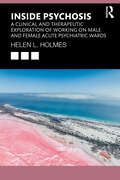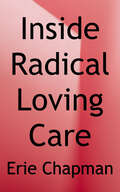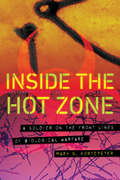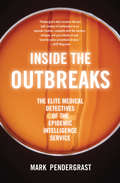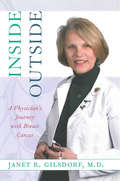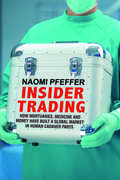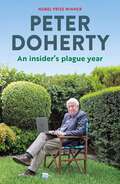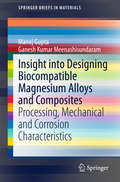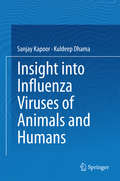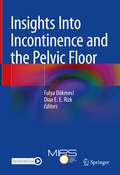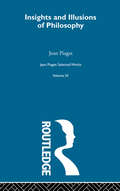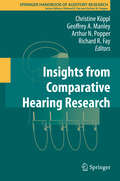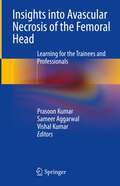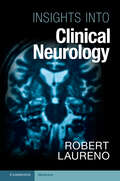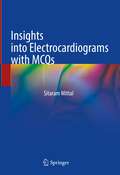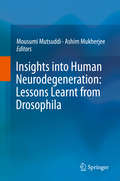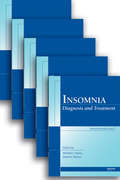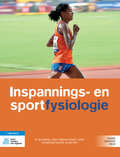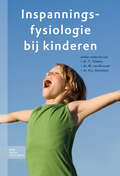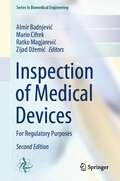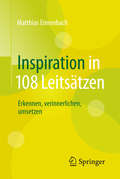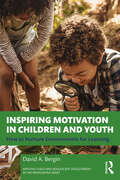- Table View
- List View
Inside Psychosis: A clinical and therapeutic exploration of working on male and female acute psychiatric wards
by Helen L HolmesThis book offers an introductory overview of treatment of psychosis in inpatient acute ward settings, looking at both male and female wards. Taking a broadly psychoanalytic perspective, the book explores the organizational dynamics on male and female acute wards, exploring both patient and staff dynamics. Containing detailed case studies from across male and female psychiatric wards in London, the author sets out how psychoanalytic concepts, such as transference, questions of trauma, and issues of gender can shape both the presentation of psychosis and our understanding and treatment of it. The book then explores the part played by religion in psychosis and equips readers with ideas for future practice and training on psychosis. With clear guidance on how to understand and work with psychosis in an inpatient setting, and how many unconscious factors can affect patients and staff, this is key reading for psychiatrists, psychoanalysts and therapists, clinical psychologists, and other mental health professionals working in inpatient acute care and community settings.
Inside Radical Loving Care
by Erie ChapmanThis book distills the essence of the author's three previous books into a single slender volume. It equips caregivers with stories of powerful examples and all the tools they need to live Love, not fear, every day and night. Execute the ideas in this book and your life and your work culture will change for the better. As a result, every patient's care will improve.
Inside the Hot Zone: A Soldier on the Front Lines of Biological Warfare
by Mark G. KortepeterInside the Hot Zone is an insider&’s account of one of the most dangerous workplaces on earth: the United States Army Medical Research Institute of Infectious Diseases (USAMRIID) in Fort Detrick, Maryland. Retired U.S. Army Col. Mark G. Kortepeter, a leading biodefense expert, recounts his journey from the lecture hall to the role of department chief, to the battlefield, to the Biosafety Level-4 maximum containment lab, and finally, to the corner office. During Kortepeter&’s seven and a half years in leadership at USAMRIID, the United States experienced some of the most serious threats in modern germ warfare, including the specter of biological weapons during the Iraq War, the anthrax letters sent after 9/11, and a little-known crisis involving a presumed botulism attack on the president of the United States. Inside the Hot Zone is a shocking, frightening eye-opener as Kortepeter describes in gripping detail how he and his USAMRIID colleagues navigated threats related to anthrax, botulism, smallpox, Lassa, and Ebola. Kortepeter crafts a rich and riveting narrative as he wrestles with life-and-death decisions managing biological weapon exposures. The stories are real, but they could just as easily serve as plotlines in popular fiction or Hollywood thrillers. He gives the reader a seat at the table as each crisis unfolds, with an unvarnished and personal perspective on the dangers, the drama, the fear, the frustrations, the irony, and the uncertainty he encountered as a physician in the role of &“Biodefender.&”
Inside the O'Briens: A Novel
by Lisa GenovaFrom the New York Times bestselling author of Still Alice Lisa Genova comes a powerful and transcendent new novel about a family struggling with the impact of Huntington's disease.Joe O'Brien is a forty-four-year-old police officer from the Irish Catholic neighborhood of Charlestown, Massachusetts. A devoted husband, proud father of four children in their twenties, and respected officer, Joe begins experiencing bouts of disorganized thinking, uncharacteristic temper outbursts, and strange, involuntary movements. He initially attributes these episodes to the stress of his job, but as these symptoms worsen, he agrees to see a neurologist and is handed a diagnosis that will change his and his family's lives forever: Huntington's Disease. Huntington's is a lethal neurodegenerative disease with no treatment and no cure. Each of Joe's four children has a 50 percent chance of inheriting their father's disease, and a simple blood test can reveal their genetic fate. While watching her potential future in her father's escalating symptoms, twenty-one-year-old daughter Katie struggles with the questions this test imposes on her young adult life. Does she want to know? What if she's gene positive? Can she live with the constant anxiety of not knowing? As Joe's symptoms worsen and he's eventually stripped of his badge and more, Joe struggles to maintain hope and a sense of purpose, while Katie and her siblings must find the courage to either live a life "at risk" or learn their fate. Praised for writing that "explores the resilience of the human spirit" (The San Francisco Chronicle), Lisa Genova has once again delivered a novel as powerful and unforgettable as the human insights at its core.
Inside the Outbreaks: The Elite Medical Detectives of the Epidemic Intelligence Service
by Mark PendergrastThe &“fascinating&” story of the CDC&’s intrepid investigators, who travel the world to protect us from deadly pathogens (Chicago Tribune). Since its founding in 1951, the Epidemic Intelligence Service has waged war on every imaginable ailment. When an epidemic hits, the EIS will be there to crack the case, however mysterious or deadly, saving countless lives in the process. Over the years they have successfully battled polio, cholera, and smallpox, to name a few, and in recent years have turned to the epidemics killing us now—smoking, obesity, and gun violence among them. The successful EIS model has spread internationally: former EIS officers on the staff of the Centers for Disease Control have helped to establish nearly thirty similar programs around the world. EIS veterans have gone on to become leaders in the world of public health in organizations such as the World Health Organization. Inside the Outbreaks takes readers on a riveting journey through the history of this remarkable organization, following Epidemic Intelligence Service officers on their globetrotting quest to eliminate the most lethal and widespread threats to the world&’s health.
Inside/Outside: A Physician's Journey with Breast Cancer
by Janet R. GilsdorfIn 2000, pediatrician and epidemiologist Janet Gilsdorf (U. of Michigan Medical School) learned that she had breast cancer. In this memoir, she uses a stream-of-consciousness style to recount her journey from diagnosis through various treatments and (ultimately) recovery. She also offers a vivid account of the struggle she faced in reconciling her dual identity as physician and patient. Annotation ©2007 Book News, Inc. , Portland, OR (booknews. com)
Insider Trading: How Mortuaries, Medicine and Money Have Built a Global Market in Human Cadaver Parts
by Naomi PfefferThe cadaver industry in Britain and the United States, its processes and profits Except for organ transplantation little is known about the variety of stuff extracted from corpses and repurposed for medicine. A single body might be disassembled to provide hundreds of products for the millions of medical treatments performed each year. Cadaver skin can be used in wound dressings, corneas used to restore sight. Parts may even be used for aesthetic enhancement, such as liquefied skin injections to smooth wrinkles. This book is a history of the nameless corpses from which cadaver stuff is extracted and the entities involved in removing, processing, and distributing it. Pfeffer goes behind the mortuary door to reveal the technical, imaginative, and sometimes underhanded practices that have facilitated the global industry of transforming human fragments into branded convenience products. The dead have no need of cash, but money changes hands at every link of the supply chain. This book refocuses attention away from individual altruism and onto professional and corporate ethics.
Insider's Plague Year
by Peter DohertyIn An Insider's Plague Year, Nobel laureate and prominent COVID-19 authority Professor Peter Doherty recounts his response to the pandemic as it developed from January 2020-February 2021. As citizens and governments around the world suddenly became acutely dependent on the capacity of scientists to understand and recommend appropriate public health policy responses to the disease, Doherty and his team were at the forefront. In his always conversational style, Doherty systematically provides a deep understanding of the virus and of the numerous areas of knowledge that have been brought together in the fight against it. Rendering complex medical and scientific issues accessible and providing a fascinating glimpse into how health experts have worked with governments to control and manage the challenge, Doherty also turns his mind to what we can hope for in the months and years ahead, considering even larger questions about the pivotal role of science in our lives.
Insight into Designing Biocompatible Magnesium Alloys and Composites
by Manoj Gupta Ganesh Kumar MeenashisundaramThis book critically summarizes the effects of various suitable alloying elements and particulate reinforcements on mechanical and degradation properties of pure Mg and Mg alloys targeting biomedical applications. The suitability of alloying elements and particulate reinforcements are discussed based on their levels of toxic effects on human body. First attempt is made to study and discuss on the various available synthesizing techniques for fabrication of both impermeable and porous Mg materials. Further, more emphasis on development of new magnesium matrix nanocomposites (MMNC) is made owing to the similarities between natural bone and MMNCs as bio-"nanocomposite". The information on synthesis, toxicity of alloying elements and reinforcements and their effects on mechanical and degradation properties of pure Mg will enable the researchers to effectively design Mg alloys and composites targeting biomedical applications.
Insight into Influenza Viruses of Animals and Humans
by Sanjay Kapoor Kuldeep DhamaThis book provides salient information on all aspects of influenza/flu viruses affecting animals and humans. It specifically reviews the properties and replication of influenza viruses; their evolution and emergence; epidemiology; role of migratory birds in disease transmission; clinical signs in humans, animals and poultry; pathogenesis and pathogenicity; public health importance and potential threats; diagnosis; prevention and control measures; and pandemic preparedness. Influenza/flu viruses evolve continuously and jump species causing epidemics as well as pandemics in both human and animals. During the past 150 years, various strains of influenza virus like the Spanish flu, Asian flu, Hong Kong flu, bird flu and swine flu were responsible for high mortality in humans as well as birds. High mutation rates, antigenic shifts, drifts, reassortment phenomena, and the development of antiviral drug resistance all contribute to ineffective chemotherapy and vaccines against influenza viruses. Due to their devastating nature, high zoonotic implications and high mortality in humans and poultry, they have a severe impact on the socioeconomic status of countries. Disease awareness, rapid and accurate diagnosis, surveillance, strict biosecurity, timely adoption of appropriate preventive and control measures and pandemic preparedness are crucial to help reduce virus transmission, thus reducing clinical cases, deaths and pandemic threats.
Insights Into Incontinence and the Pelvic Floor
by Fulya Dökmeci Diaa E. E. RizkThis book collects valuable studies in the field of pelvic medicine, reflecting the latest technologies and innovations for maintaining pelvic floor health and managing incontinence and pelvic floor disorders in both men and women. It provides an authoritative and multidisciplinary perspective from Mediterranean experts in the field, mainly focusing on obstetrics and gynecology, urogynecology, urology, female urology, colorectal surgery, and physiotherapy. Collecting innovative ideas and studies based on recent developments, with detailed background information, the book will shed new light on the subject and serve as a valuable reference guide for graduate students, researchers, and practicing professionals interested in continence and pelvic floor management.
Insights and Illusions of Philosophy: Selected Works vol 9
by Jean PiagetFirst published in 1997. Routledge is an imprint of Taylor & Francis, an informa company.
Insights from Comparative Hearing Research
by Arthur N. Popper Richard R. Fay Christine Köppl Geoffrey A. ManleyThe hearing organs of non-mammals, which show quite large and systematic differences to each other and to those of mammals, provide an invaluable basis for comparisons of structure and function. By taking advantage of the vast diversity of possible study organisms provided by the "library" that is biological diversity, it is possible to learn how complex functions are realized in the inner ear through the evolution of specific structural, cellular and molecular configurations. Insights from Comparative Hearing Research brings together some of the most exciting comparative research on hearing and shows how this work has profoundly impacted our understanding of hearing in all vertebrates.
Insights into Avascular Necrosis of the Femoral Head: Learning for the Trainees and Professionals
by Vishal Kumar Prasoon Kumar Sameer AggarwalThe book is an overview of a vital Orthopedics topic, avascular necrosis (AVN) of the hip. It encompasses all the aspects of this disease in terms of etiology, epidemiology, pathogenesis, diagnosis, staging, and treatment. It covers the recent advances and evidence-based approaches to diagnosis and management, with easy to understand tables and pictures. This book is a comprehensive guide with chapters on presentation and examination of such a case with knowledge about frequently asked questions. Included multiple-choice questions on the topic will further aid in revision and recapitulation. This book is a helpful tool for Senior Residents, faculty members in teaching institutions as well as practicing Orthopedic surgeons all across the globe. Knowing how to examine, diagnose and manage a case of AVN hip is a must for any Orthopedic surgeon, and they have to be aware of all recent advances without fail. This book is on a topic which is a “must keep” clinical case in all Orthopedic exit exams; encapsulated with every nuance of the disease, it will be beneficial across all the career stages of Orthopedic surgeons.
Insights into Clinical Neurology
by Robert LaurenoThis illuminating book clarifies controversial topics in challenging and often confusing areas of neurology for all who are interested in clinical neuroscience. It provides an organized approach to neurological conditions such as amnesic syndrome, aphasia, agnosia and apraxia, it includes previously unpublished data on grasp reflex and Wernicke disease is presented. Written by an internationally renowned author, the book draws on his extensive personal experience to orient neurological clinicians to a variety of conditions by putting less accessible literature into context with recent advances and information from interviews undertaken throughout his career. This book will appeal to general and specialist neurologists, nurse practitioners, physician's assistants and those training to specialise in neurology.
Insights into Electrocardiograms with MCQs
by Sitaram MittalThe present is bundled with several unique features. It provides up-to-date information on electrocardiograms for almost all electrocardiographic abnormalities covers all aspects of surface electrocardiography in detail. Summaries follow all book chapters for quick revision and MCQs for self-assessment. This book will be helpful to clinicians, fellows in medicine preparing for different careers in cardiology, and ECG technicians and their teachers.The purpose of writing this book - While teaching undergraduates, postgraduates in general medicine, and students of diploma course in cardiac instrument technology, I realized that the students did not have the knowledge of basic concepts of electrocardiography and did not know the clinical significance of various abnormalities. Students, therefore, felt that the subject was difficult to understand and of no clinical significance. Students, therefore, did not feel interested. There was a need for a book that could simplify the subject to the ground level for a beginner who does not know even the basics of electrocardiography. Most of the books in this field are targeted towards cardiologists with an understanding that the reader already has enough knowledge of the basic concepts of electrocardiography. MCQs are the cornerstone for learning, teaching, and evaluation. None of the books in the market gives the idea of MCQs in electrocardiography. What problem does this book solve for the readers? - This book explains various normal and abnormal findings with the help of diagrams and illustrative electrocardiograms. Clinical implications of multiple abnormalities are discussed. This makes the subject easy to understand and to interest for a beginner. MCQs will help the readers in self-assessment. MCQs will also help teachers and examiners in evaluating the students.
Insights into Human Neurodegeneration: Lessons Learnt from Drosophila
by Mousumi Mutsuddi Ashim MukherjeeThis book is aimed at generating an updated reservoir of scientific endeavors undertaken to unravel the complicated yet intriguing topic of neurodegeneration. Scientists from Europe, USA and India who are experts in the field of neurodegenerative diseases have contributed to this book. This book will help readers gain insight into the recent knowledge obtained from Drosophila model, in understanding the molecular mechanisms underlying neurodegenerative disorders and also unravel novel scopes for therapeutic interventions. Different methodologies available to create humanized fly models that faithfully reflects the pathogenicities associated with particular disorders have been described here. It also includes information on the exciting area of neural stem cells. A brief discussion on neurofibrillary tangles, precedes the elaborate description of lessons learnt from Drosophila about Alzheimer's, Parkinson’s, Spinomuscular Atrophy, Huntington’s diseases, RNA expansion disorders and Hereditary Spastic Paraplegia. We have concluded the book with the use of Drosophila for identifying pharmacological therapies for neurodegenerative disorders. The wide range of topics covered here will not only be relevant for beginners who are new to the concept of the extensive utility of Drosophila as a model to study human disorders; but will also be an important contribution to the scientific community, with an insight into the paradigm shift in our understanding of neurodegenerative disorders. Completed with informative tables and communicative illustrations this book will keep the readers glued and intrigued. We have comprehensively anthologized the lessons learnt on neurodegeneration from Drosophila and have thus provided an insight into the multidimensional aspects of pathogenicities of majority of the neurodegenerative disorders.
Insomnia: Diagnosis and Treatment
by Daniel J. Buysse Michael J. SateiaThe first source on insomnia treatment since the advancement of newer drug options and cognitive behavioral therapies, Insomnia: Diagnosis and Treatment presents a comprehensive reference on the complications, evaluation, and treatment of insomnia. Ideal for sleep medicine specialists, psychiatrists, and neurologists, this text uses a multi-discipl
Insomniac
by Gayle GreeneIn this revelatory book, Gayle Greene offers a uniquely comprehensive account of insomnia, a devastating and little-understood condition. She shares comments from neurologists, sleep researchers, doctors, psychotherapists, and insomniacs of all sorts. This work provides an up-to-date account of what is known about the little known realm of insomnia.
Inspannings- en sportfysiologie
by Jack H. Wilmore David L. Costill W. Larry KenneyInspanningsfysiologie is dé basis voor het begeleiden van bewegen, bijvoorbeeld voor training, bewegingsonderwijs en oefentherapie. Dit boek is het wereldwijde standaardwerk voor de inspannings- en sportfysiologie. De auteurs van de Amerikaanse uitgave, Larry Kenney, Jack Wilmore en David Costill, zijn absolute topwetenschappers op dit vakgebied. Deze vierde, geheel geactualiseerde, Nederlandse editie van Inspannings- en sportfysiologie biedt toegankelijke, goed leesbare, wetenschappelijk onderbouwde, up-to-date kennis. Dit bijzonder complete boek besteedt veel aandacht aan de basisinspanningsfysiologie: Hoe werkt het menselijke lichaam tijdens inspanning? Daarnaast kijkt het uitgebreid naar de invloed van de omgeving op ons lichaam (hoogte, warmte, kou) en naar de invloed van leeftijd en sekse bij inspanning en sport. Verder wordt ingegaan op trainen voor prestaties, en de invloed daarop van voeding en lichaamssamenstelling. Ook de aanpak en effecten van bewegen gericht op gezondheid komen uitgebreid aan de orde. Deze editie is uitgebreid met nieuwe informatie over uiteenlopende onderwerpen als moleculaire adaptaties, obesitas, diabetes type II, bioinformatica, eiwitsynthese en spierkramp. De uitgave is rijk geïllustreerd en bevat tal van praktische en aansprekende voorbeelden en zelfstudievragen aan het eind van elk hoofdstuk. Online zijn Engelstalige videofragmenten en animaties beschikbaar Gedegen kennis van inspannings- en sportfysiologie is onmisbaar voor (aankomende) bewegingswetenschappers, docenten lichamelijke opvoeding, fysiotherapeuten, coaches, trainers en andere professionals op het gebied van bewegen. Met de kennis van Inspannings- en sportfysiologie, zowel een handboek als een compleet naslagwerk, is het mogelijk uit te groeien tot een professionele begeleider. De vertaler, drs. Gerard van der Poel, is bewegingswetenschapper (VU, 1989) en werkt sinds 1993 als zelfstandig inspanningsfysioloog. Gerard is een zeer ervaren docent, trainer, adviseur en auteur. Hij verzorgt onder meer nascholingen voor fysiotherapeuten en trainers. Gerard van der Poel is (mede)auteur van zes boeken en vele artikelen in vaktijdschriften.
Inspanningsfysiologie bij kinderen: Van wetenschap naar praktijk
by T. Takken, M. Brussel and H.J. HulzebosVoor (chronisch) zieke kinderen is een goed inspanningsvermogen een onmisbare voorwaarde om deel te kunnen nemen aan het maatschappelijk leven. Bewegingsprogramma's nemen hierdoor een steeds belangrijkere plaats in binnen de zorg voor chronisch zieke kinderen en jongeren. Bewegingsprogramma's zijn vooral gericht op het verbeteren van functionele capaciteiten.In Inspanningsfysiologie bij kinderen gaan de auteurs uitgebreid in op inspanningsfysiologie en training bij kinderen en jongeren. In het eerste gedeelte van het boek worden de basisbegrippen uit de pediatrische inspanningsfysiologie besproken. Het tweede gedeelte behandelt de meest voorkomende chronische ziekten en aandoeningen bij kinderen aan bod. De auteurs geven hierbij aan wat fitheid en training voor kinderen met zo'n chronische aandoening kunnen betekenen.
Inspection of Medical Devices: For Regulatory Purposes (Series in Biomedical Engineering)
by Almir Badnjević Mario Cifrek Ratko Magjarević Zijad DžemićThis comprehensive guide invites nations worldwide to embark on a transformative journey, implementing independent third-party verification systems that ensure medical devices comply with both international and national regulations. Prepare to be captivated as we delve into the intricate processes, unveil essential procedures, and illuminate the paramount importance of establishing traceability for medical device measurements.Imagine a world where medical devices undergo rigorous independent safety and performance verification, guaranteeing the utmost reliability for patient diagnoses and treatment. This book takes you on a compelling exploration of precisely that vision. Focusing on cutting-edge diagnostic and therapeutic devices, it captures the very essence of the latest international directives and regulations, ensuring you stay ahead of the curve.This new edition goes beyond the conventional, delving into the realms of innovation and progress. Unveiling in-depth maintenance regimes within healthcare institutions, we provide you with invaluable insights into post-market surveillance. As the world embraces the transformative potential of artificial intelligence, we pave the way for evidence-based management of medical device maintenance—a concept poised to reshape the healthcare landscape.Imagine a future where medical devices are seamlessly integrated into the legal metrology system, while fully operational national laboratories for medical device inspection set new standards of excellence. This book vividly illustrates how such a powerful union can elevate the reliability of medical devices in diagnosis and patient care. Brace yourself for a paradigm shift that not only enhances efficacy but also leads to significant cost reductions within your country's healthcare system.Join us on this extraordinary journey as we unveil the untapped potential of medical device inspection. With our innovative approach and unrivaled expertise, together we can revolutionize healthcare, transforming the lives of countless patients worldwide. Get ready to be inspired, informed, and empowered—welcome to the future of healthcare!
Inspiration for Every Day: 365 Ideas to Spark Creativity
by Lizzie CornwallCreativity. Productivity. Joy. Just one tiny flicker can spark inspiration that fuels you all day. Let these moving words, smart tips and beautiful images stimulate your mind, tap into the well of your imagination, and move you to be inspired every day.
Inspiration in 108 Leitsätzen: Erkennen, verinnerlichen, umsetzen
by Matthias EnnenbachDieses Buch möchte Ihnen anhand von 108 kurzen Leitsätzen konkrete Anregungen und Anleitungen zur Selbstentfaltung und Potentialentwicklung anbieten. Vielleicht sind Sie interessiert und offen für Inspirationen, um sich weiterzuentwickeln, aus alten Mustern herauszukommen, endlich friedlich und glücklich leben zu können? Dieses Buch lädt Sie auf eine leichte Weise dazu ein, Schritt für Schritt eine bewährte Geistesschulung nachzuvollziehen. Sie werden bei der Lektüre dieses Buches feststellen, dass es hier nicht so sehr um reine Wissensvermittlung geht, sondern um die Beschreibung eines Weges zu sich selbst. Es ist eine Anregung, sich der in Ihnen bereits vorhandenen Qualitäten zu öffnen. Der Zugang ist heute kein Mysterium mehr, er wird hier in sehr konkreten und nachvollziehbaren Schritten beschrieben. Es sind nur 108 Sätze nötig.Aus dem InhaltDie 108 zentralen Leitsätze werden jeweils in einem kurzen Kapitel auf ein bis zwei Seiten ausgeführt, transparent gemacht und bezüglich ihrer Umsetzung verdeutlicht.
Inspiring Motivation in Children and Youth: How to Nurture Environments for Learning (Applying Child and Adolescent Development in the Professions Series)
by David A. BerginInspiring Motivation in Children and Youth: How to Nurture Environments for Learning explores motivation and its crucial role in promoting well-being in the classroom and life beyond school. It will help all those who work with children and youth to understand and improve their motivation, and to create nurturing environments for younger people. David Bergin provides a highly accessible exploration of key research, examining the ways children’s goals, self-efficacy, self-determination, and feelings of being cared for affects their motivation as well as their desire to learn more about themselves and the world. This essential guide also addresses influences of competition, diversity, prejudice, and discrimination on motivation. The book provides a comprehensive look at the importance of instilling motivation at this critical age, highlighting the benefits through real-life examples and anecdotes. Illustrated with stories from diverse contexts, the author provides practical advice on how to use goals effectively, help children feel competent, autonomous, and like they belong. Inspiring Motivation in Children and Youth is for any student looking to excel in a psychological, educational, health, or social work setting, as well as professionals in the field, and parents. It is targeted for people who work or plan to work with children from pre-school to high school and will be useful to teachers, youth leaders, coaches, counselors, social workers, and nurses.
